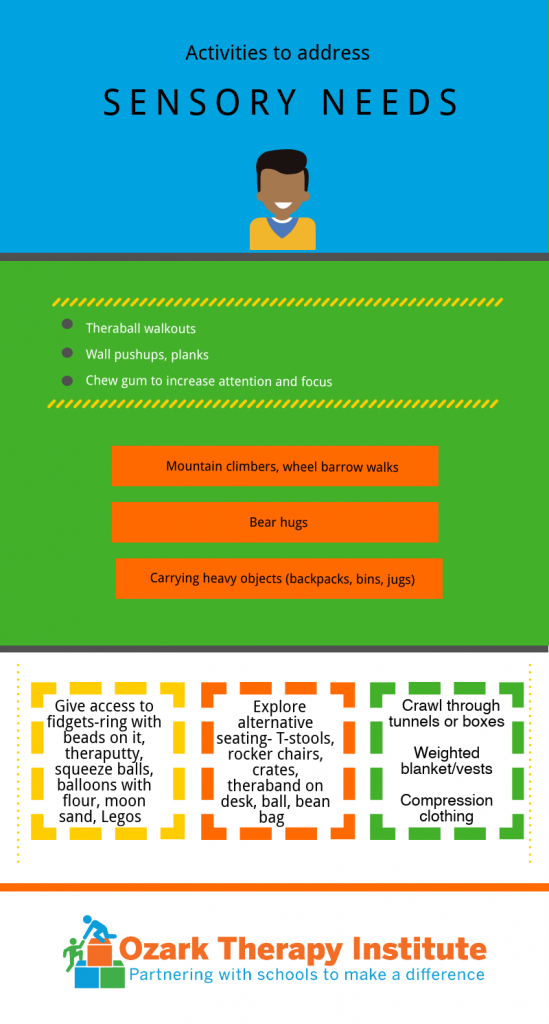Children with sensory processing disorders can find it challenging to navigate everyday situations. Sensory issues can affect a student’s ability to learn in the typical classroom environment. As a teacher, there are some simple strategies you can employ in the classroom to help make them feel more comfortable.
Why is Learning Difficult for a Child with Sensory Needs?
It is difficult for a child with special sensory needs to manage the information their five senses are giving them. They may exhibit increased sensitivity (hypersensitivity), or muted sensitivity (hyposensitivity), to sights, sounds, touch, tastes, or smells. In addition, they may lack coordination or a sense of body awareness.
A hypersensitive student might be easily distracted or become agitated by noises, bright lights, or textures that feel uncomfortable to them. Hyposensitivity can manifest as an inability to sit still, a tendency to play rough, or showing a high tolerance for pain.
If you have observed behaviors like these in a student, it is best to discuss them with the child’s parent/s as well as the school’s special education director and/or occupational therapist. If a sensory processing disorder diagnosis has been made, there are things you can do to accommodate the child’s special sensory needs.
Here is a handy infographic with ideas for activities to address those sensory needs:

[Text] Activities to Address Sensory Needs
- Thera-ball walkouts
- Wall pushups, planks
- Chew gum to increase attention and focus
- Mountain climbers, wheelbarrow walks
- Bear hugs
- Carrying heavy objects (backpacks, bins, jugs)
- Give access to fidget-ring with beads on it, Theraputty, squeeze balls, balloons with flour, moon sand, Legos
- Explore alternative seating: T-stools, rocker chairs, crates, TheraBand on desk, ball, bean bag
- Crawl through tunnels or boxes
- Weighted blanket/vests (Talk to an occupational therapist before using this strategy to avoid overstimulation)
- Compression clothing (Talk to an occupational therapist before using this strategy to avoid overstimulation)
First, Assess the Situation
Before implementing any plan for a student with special sensory needs, it is important to observe each child’s unique behaviors and reactions. Once you know what triggers them, you can formulate a strategy. For example, if a child is easily startled and agitated by sudden loud noises, you could give them advance warning a few minutes before the bell rings.
The special ed department and occupational therapists at your school will be able to assess the student and offer suggestions on changes you can make to your classroom routines.
What Can a Teacher Do to Accommodate Sensory Needs?
The ways you can help fall into two general categories: adjustments you can make to the child’s environment to ease their discomfort, and activities you can coordinate to help them focus. The ultimate goal is to help the student succeed along with the rest of the class.
Creating a Welcoming Environment
By adjusting small things in the classroom, a teacher can make a student with sensory needs more able to focus and learn. Some changes that can have a big impact are:
Offer alternative seating. Allow the child to use a stool, bean bag, or stand-up desk. Use an elastic therapy band around the front legs of their chair so they can bounce their feet. The more comfortable they are, the better they’ll be able to focus. Whatever you choose, the seat should be a good fit, allowing them to have both feet flat on the floor.
Try dimming or turning off fluorescent lights that can glare or buzz.
Assign a seat that is farthest away from distraction, such as the door or windows. Some children might do best seated near the teacher. Others may need to turn around whenever a classmate speaks. Knowing what triggers your student will help you make the appropriate choice.
Allow them to hold and play with fidget toys, squeeze balls, or putty. For some students with sensory needs, chewing gum helps them focus. Offering a weighted blanket or weighted vest can comfort a child who is anxious.
Build These Activities for Sensory Needs into Your Routine
Children with sensory processing disorder usually benefit from sticking to a routine. Variations can be confusing and upsetting. For this reason, it is best to establish a schedule that the student can understand. Alerting them ahead of time to changes in what they’re used to can help alleviate the stress they may feel.
Plan “sensory breaks” into your usual classroom timetable. During these breaks, you will acknowledge and work with any attention span issues. The break will allow the child to step away from the lesson for a few minutes and reboot.
Some physical activities to try might be wall push-ups or mountain climbers. Wheelbarrow walks and bear hugs with a classmate can be helpful. Or have them carry objects, crawl through tunnels or boxes, or jump on a mini-trampoline.
These actions and movements can help them refocus and re-engage with the rest of the class.
Helping Students with Sensory Needs Succeed
Students with sensory needs can find the classroom an overwhelming place. Implementing some of these ideas can help lower their anxiety and prepare them to focus and engage in the classroom. As a result, they’ll be better able to learn, reach their goals, and succeed.



